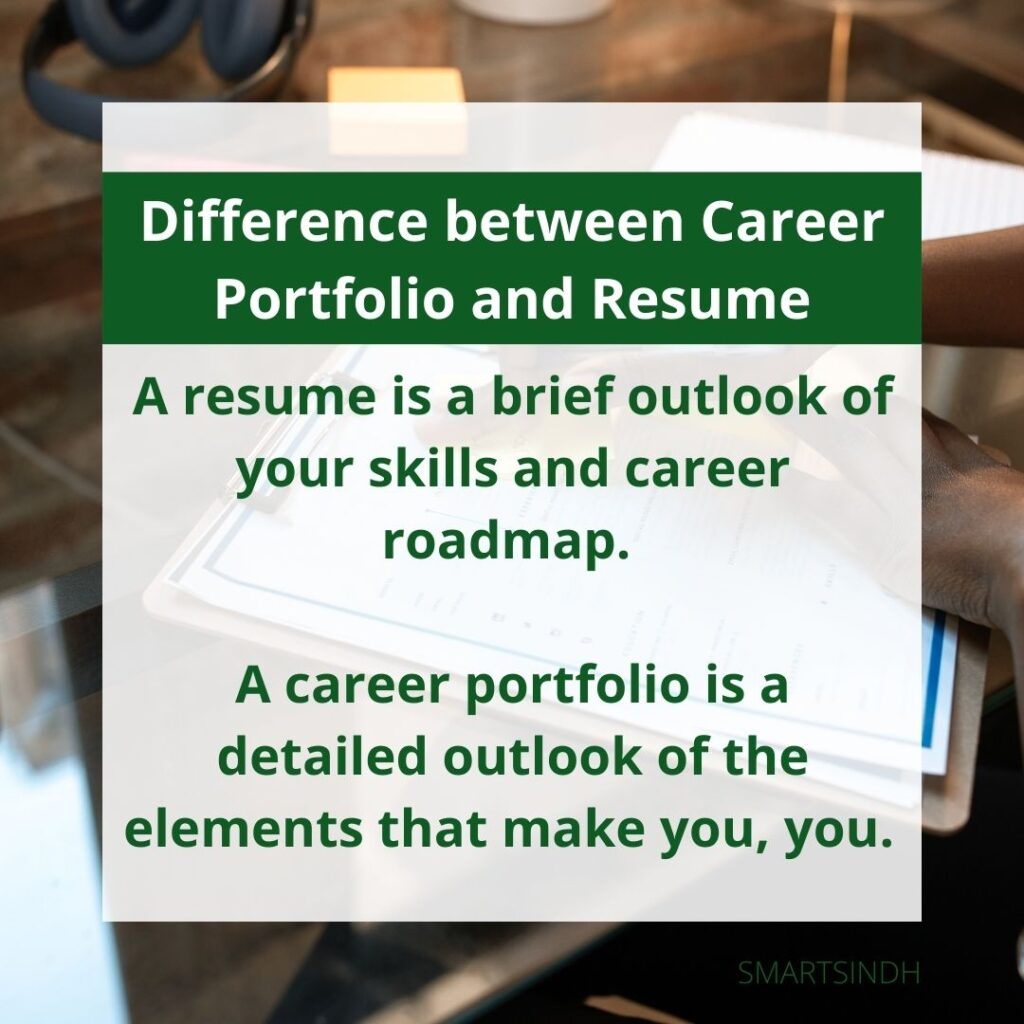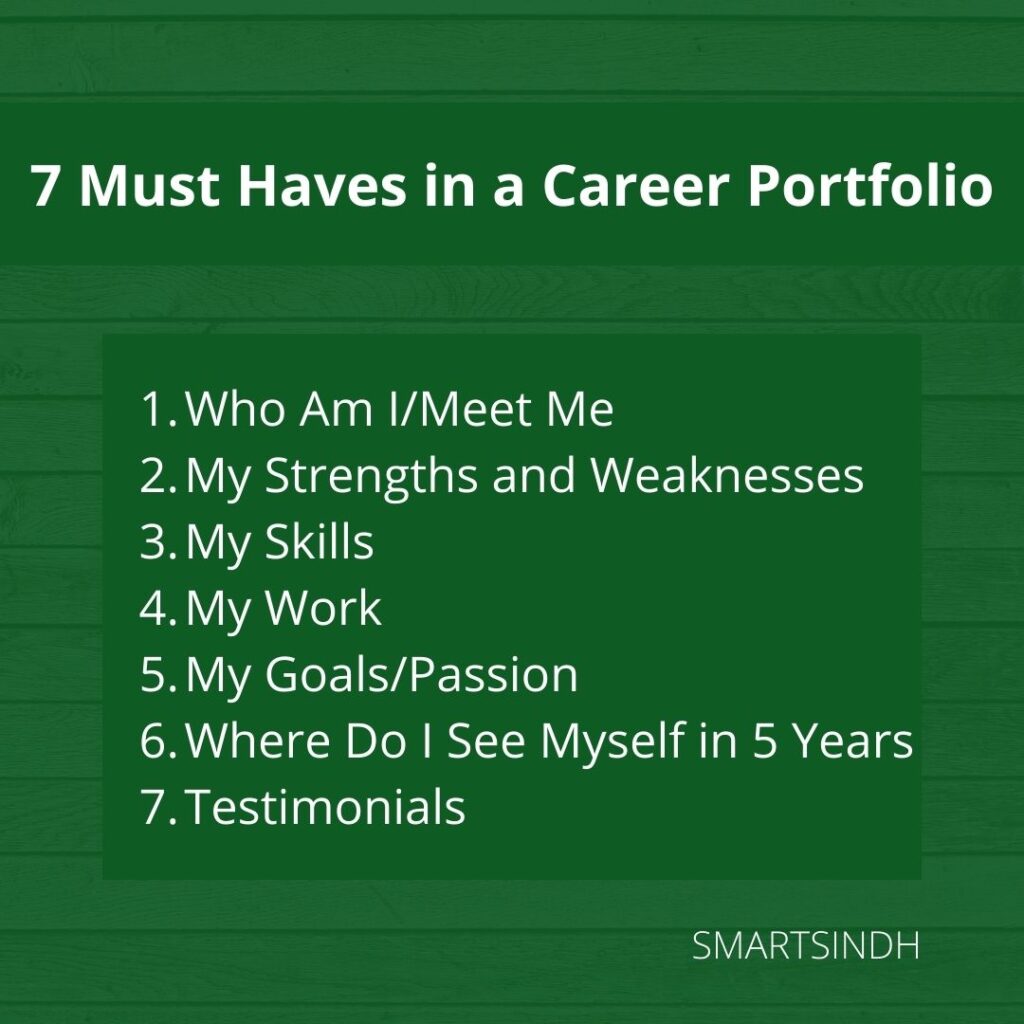What is a career portfolio? Who needs it? How to make it? What do you include in a career portfolio?
Here, we are going to answer all questions about a career portfolio.
What is a Career Portfolio?
A career portfolio is like a window to your personality. The market is saturated, and the companies want to invest in talented individuals who are passionate and goal-oriented.
With the help of a career portfolio, you can display your personality and qualities. A career portfolio tells the companies why you are a right fit for them.
Difference between Resume and Career Portfolio
A resume is a brief outlook of your skills and career roadmap. It could be a one-page brief or longer. However, employers prefer one-page and to the point resumes.
A career portfolio is a detailed outlook of the elements that make you, you. It includes elements that assisted you to reach where you are. These elements will support your future growth. They also display your potential.
In simple words, a resume explains “what are your skills”, and a career portfolio explains “who you are”.

Who Needs a Career Portfolio?
Imagine an employer recruiting in a saturated market. The company posts a job and receives 200 resumes in response. After first scan, the employer finds that only 3 resumes mention a link to career portfolio. This means that these 3 profiles have already stood out among 200 resumes.
Through the portfolio, the employer has a clearer picture of who the candidates are, what are their goals, how they see their future, how they view the industry, etc. These are the questions usually answered in the first interview. At this stage, these 3 profiles have already answered the questions of the first interview.
Who do you think the employer will interview first?
You got it!
Everyone needs a career portfolio. Even if you do not belong to the digital or creative industry, you still need a career portfolio.
- A career portfolio makes you stand out among others.
- It increases your chances of recruitment by several folds.
- It answers the question, “why an employer should hire you?”
- It builds your authority in your niche/industry.
- It displays your dedication and seriousness in career growth and development.
How to Make a Career Portfolio?
Recruiters do not get blown away with resumes, but a strong career portfolio can make them impressed even if you have just graduated. Here is a step-by-step breakdown on how you can make a powerful career portfolio.
Select a Platform
Many digital platforms provide free themes to build your own portfolio. WordPress is the most trusted platform among all. It is also the easiest one and provides a good variety of themes.
- Go to www.wordpress.com
- Click on “get started”.
- Create an account with your email ID on Sign Up page.
- Select password and blog name. Your blog name would be your URL also. For example, if you choose ABC, your blog’s URL would be www dot ABC dot wordpress dot com. If you want a domain name with your chosen blog’s name only, like www dot ABC dot com, you will need a paid domain.
- Confirm your email and activate the blog now.
- Log in to your blog through your portfolio URL/wp-admin/.
- Go to the Dashboard, click on Settings, then choose Themes.
- You can select a free theme from the search bar. For example, if you are a photographer, you can write “photographer” in the search bar at Themes Page. Select a theme and click on “activate”.
- Once your theme is activated, you can go to “customize theme” to select colors, and change pictures and text.
If you need assistance in creating your professional career portfolio, you can get in touch with us.
Select Professional Pictures
To select professional pictures for career portfolio, consider how you would want to look when going for an interview. Keep the following points in mind.
- The picture should have a plain background. You can also go in a natural setting with least noise.
- Your face should cover at least 60% of the picture.
- Wear professional clothes. Your dress should resemble the way you would dress for an interview. Read our blog How to Prepare for Your First Interview for further understanding.
- Ask someone else to take your pictures. Do not use selfies in the career portfolio.
- Carry the right expression. Keep your face straight, but hold a friendly smile.
You can take good photos with mobile phone camera. Try to capture photos in HD or high resolution. You can also visit a photo studio and explain the purpose of your photos to the photographer.
Link to Social Media Handles
After setting up the theme of your career portfolio and posting the pictures, the next step is to link it with the social media handles. A majority of the WordPress themes provide widgets to link your social media handles.
If the theme you have selected provides social widgets, then you can link the social media handles by following the given process.
- Log in to your WordPress blog.
- See the left menu. Go to Appearance, then Customize.
- Go to Menus, click on Create New Menu.
- Write a description for the menu.
- Click on Social Links Menu and click Next.
- Click on Add Items.
- In the expanded menu, put the custom links of your social media handles. Add each custom link through Add Items button.
You can include links to FaceBook, LinkedIn, Twitter, etc. Instagram is a good option to put only if you use it to express your non-political and career views.
Include in Your Resume
The next step now is to include your career portfolio in your resume. Here is sample text to mention your career portfolio in resume.
Sample 1
Here is a link to my career portfolio <insert link>.
Sample 2
Find more about my passion, goals, and professional journey at <insert link>.
Sample 3
Find a little more about me at <insert link>.
We have to keep the text to career portfolio brief but self-explanatory in the resume.
7 Must Haves in a Career Portfolio
It’s time to write the text of your career portfolio. We want to create a knockout first impression to the recruiters. Here is how you can do it.
- Use MS Word to write the text. You can also change the text directly in the theme.
- Copy the section of text in your WordPress theme and paste it on your MS Word file. Now write the text to replace the sample text in your blog.
- Make sure that the length of text does not alter the design of your theme. To do this, select the text on the blog and check the number of characters with space. When you write the text about yourself, make sure that the number of characters with space is equal to the sample text in the blog.

Here are the 7 elements you must include in your career portfolio text.
You can write a short description about yourself at the Home Page and a detailed description in the About Me Page.
Who Am I/Meet Me
When it comes to creativity in About Me, sky is the limit. This section will explain the recruiters how you view yourself. It gives you a chance to convince the recruiters by expressing your passion for career growth and development.
- Start with your name and profession. If you are a beginner, you can mention your recently completed education here.
- Mention your recent professional activities or any volunteer contribution. Remember to include the recent work in the first paragraph. You can mention the impact your work has created in this paragraph. For example, you can write, “My volunteer community service for teaching underprivileged kids assisted 10 kids to pass the entry test and get enrolled in grades 6-8”.
- Now tell more about yourself. What ignites your passion, what gives you happiness, what makes you feel fulfilled or satisfied, what impact you want to create, etc.
You can include more details afterwards. Mention if you are willing to work in a specific situation or ready to relocate. Avoid including personal details like family and friends.
My Strengths and Weaknesses
This element falls in the About Me section. You don’t need to create a separate section on the career portfolio for strengths and weaknesses.
In this section, identify your strengths, for example, motivation, punctuality, farsightedness, problem-solving, etc.
For the weaknesses, make sure to include the solutions of the weaknesses also. This reflects self-awareness and specifies that you are working to overcome your weaknesses. For example, you can mention that lack of focus is your weakness and you are practicing meditation to improve your focus.
My Skills
Mention your skills in a separate section. A majority of WordPress themes have a Services Page. You can use this section for mentioning your skills.
Write your soft skills and technical skills separately. Your soft skills may include team work, punctuality, taking full responsibility of the project, etc. Your technical skills will reflect your expertise in your professional work, and it will differ for each industry. For example, for web developer portfolio, you can mention technical skills like CSS5, JavaScript, PhP, WordPress, etc.
While mentioning your skills, try to provide proof of each skill with an example.
- Took initiative to improve my punctuations by practicing with Grammaly.
- Managed university project on “XYZ” with a team of 6 students.
- Spoke to a public event on “XYZ” topic.
- Used interpersonal skills to ensure effective communication among team members on “ABC” project.
Examples help improve the emphasis on your skills and reinforce your compatibility and effectiveness of your skills.
My Work
This section includes your work samples, if you have any. As a beginner, you might not have much work to show. However, you can think of creating samples related to your profile. If you are a writer, you can write a few blogs. If you are a photographer, you can put a few photos in this section. Make sure to include genuine work only. Plagiarism is easy to be caught and may leave you in trouble.
Some industries, such as mechanical engineering or telecom engineering, do not have much space to create your own work samples. However, you can post your university project, thesis, and other such work in this section.
If you are experienced, include proof of your work in My Work section.
My Goals/Passion
Many interviewers ask, “why should we hire you”? In majority circumstances, they want to know about your goals and your passion. You can write your goals and passion in the Who Am I section, or make a separate section for it. Your text should answer the following.
- Why should an employer hire you?
- How do you see the future of your profession?
- Where do you see your industry/niche in next 5 years?
- How you are better than others in your industry/niche?
- What are you doing to achieve your goals/passion?
- What have you done in the past to reach your goals and passion?
- What do you plan to accomplish in your nearest milestone to get closer to your goals?
You may include any other goals you have set and achieved in the past here.
Where Do I See Myself in 5 Years?
You can include this section in your goals and passion or Who Am I. You can also create a separate section for where do you see yourself in the next 5 years.
This question identifies your understanding of the industry and its standards. To answer this question, it is best to go to LinkedIn or Google and look for companies that are offering jobs with 5 years of experience in your industry. List down the responsibilities and job description.
Then look for companies that are offering jobs for 8-10 years of experience in your industry. Note down the responsibilities and job description.
- Now, write your “where do I see myself in 5 years”. Firstly, write down your desired designation. Do not mention the name of any company. However, you can use the terms like multinational, corporation, etc.
- Then, write down the skills you need to reach there, and mention that you dream to achieve those skills in 2-3 years and gain enough experience to achieve your dream.
- You can also list down any technological assistants, apps or digital assets needed to reach where you see yourself in 5 years.
While answering this question, you will also find your roadmap to your next 5-years journey in career growth. It’s a win-win for everyone.
Testimonials
References or testimonials are a proof that you are eligible/credible for the skills and areas of expertise you have mentioned in the career portfolio. In resumes, only the name and number of the referral is mentioned, whereas in career portfolio, you can mention the name, number, designation, picture and the actual testimonial of the person. The impact of such a testimonial is bigger than just number and name.
- If you are fresh out of university, still studying, or do not have work experience, you can request your professors to testify your skills through a reference. They can write a testimonial for you to put on your career portfolio.
- If you have gained experience in the industry, then you can ask your previous employers to write a testimonial for you.
Apart from these, you can also include any awards/certificates you have received for any services related with your profession/career. You can also include details of your volunteer work or professional development activities.
A career portfolio will not only leave a knockout impression on the interested employer, but it will also give your profile a competitive edge over others. If you need any further assistance to create your undeniably impressive career portfolio, get in touch with us.

